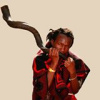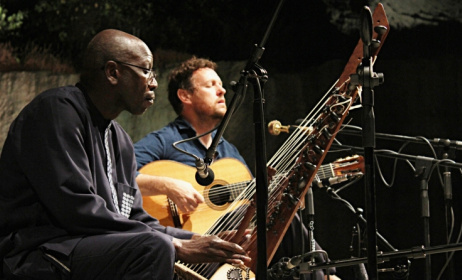Ts’iloana and ei-ei music in Lesotho
This article provides an overview of two musical forms practiced by Basotho women, ts’iloana (grinding songs) and ei-ei (lullabies).
 A Basotho woman and her child. Photo: thetravellingchilli.com
A Basotho woman and her child. Photo: thetravellingchilli.com
Basotho women and their social roles
In many ways, Basotho women form the backbone of traditional society. In some cultural contexts, they are expected to bear children and nurture families, taking on many household responsibilities in the process[1].
Two key tasks include caring for babies and grinding grains such as corn, wheat and millet – sometimes more than once a day. Both of these tasks are often accompanied by singing, and they have given rise to two unique Basotho musical forms, known as ts’iloana (grinding songs) and ei-ei (lullabies).
Ts’iloana
The leloala and ts’iloana, which together comprise a grinding stone or wheel, are regular features of the traditional Basotho kitchen. Basotho women customarily take on the responsibility of feeding their families, and this can prove an onerous task when staple grains such as corn, wheat and millet need to be ground without the aid of modern machinery. To make this mundane and painstaking work, known as ho sila,more bearable, Basotho women have developed a musical tradition to accompany the craft, singing upbeat songs, known as ts’iloana, to enthuse themselves and energise their work[2].
As mentioned, the grinding stone (leloala le ts’iloana) is made up of two granite rocks. The larger rock, with a slightly concave surface, is placed on the floor and is used to hold the coarse grain. A smaller rock, which fits into the hollow of the larger one, is then used to physically grind the grain in a sweeping, rhythmic motion. The woman will usually kneel on a rug in front of the grinding stone with two baskets nearby: one full of rough grain and an empty one, which receives the flour or meal produced. Once she is finished with preparations, she will begin her work by starting one of her favourite ts’iloana – songs which often feature lyrics dealing with community issues and topical events[3].
Although ts’iloana are largely private, personal and internal in nature, there are some notable similarities with the traditional Basotho dance known as mokhibo. This women’s dance, performed at certain community gatherings, reflects the kneeling and rhythmic shoulder movement of ho sila.
Ei-ei
According to standard definitions, a lullaby is a quiet, gentle song sung to children to help them sleep. However, Basotho women have a slightly different way of using lullabies to soothe their babies. For Basotho women, a lullaby is a song that a mother, sister or grandmother sings to herself for the benefit of the distressed baby. This practice stems from the phenomenon that, in addition to sometimes being sick, wet, hungry or sleepy, babies are perceptive enough to pick up on the energy and vibrations around them.
A Basotho woman will, therefore, put the distressed baby on her back and sing as she does her daily chores. She will sing slightly louder than the baby’s cries, and if the baby starts to scream she will raise her vocals in a dynamic fashion. Similarly, when the baby quietens down, the woman will respond by singing more gently. If the cries are such that they require her to stop working, she will hold the baby in her arms and breastfeed, or simply press the baby against her heart and gently swing sideways while tapping her foot to the rhythm of the melody. Children as young as seven months mumble the words of the lullaby, thus learning to communicate through the interactive nature of the song[4].
Ei-ei are a form of storytelling. The mother (or carer) uses them to communicate with the baby, telling the child about the family and community, and everything that troubles or brings happiness to the mother's life. The songs take the form of a two-part monologue, whereby the singer first calls out a question or a problem, and then responds to carry the story forward.
There are two other ways that Basotho women use lullabies to soothe crying or agitated babies. Reciting the baby’s clan name and totem is thought to be one way of reinforcing a budding sense of identity, while the traditional bowed instrument known as the thomo is sometimes used to accompany children’s songs, proverbs and fables[5].
Resources and citations:
- [1] http://make-upmusicmoneyme.blogspot.com/2014/03/basotho-gender-roles-and...
- [2] http://www.lesedifm.co.za/sabc/home/lesedifm/notices/details?id=5e9055d2...
- [3] https://folkways-media.si.edu/liner_notes/folkways/FW04224.pdf
- [4] https://scholarworks.umass.edu/cgi/viewcontent.cgi?referer=https://www.g...
- [5] http://www.lesedifm.co.za/sabc/home/lesedifm/notices/details?id=5e9055d2...
Disclaimer: Music In Africa's Overviews provide broad information about the music scenes in African countries. Music In Africa understands that the information in some of these texts could become outdated with time. If you would like to provide updated information or corrections to any of our Overview texts, please contact us at info@musicinafrica.net.
Editing by David Cornwell




































Comments
Log in or register to post comments